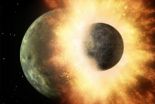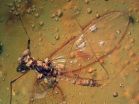(Press-News.org) The giant impact believed to have formed the Earth-Moon system has long been accepted as canon. However, a major challenge to the theory has been that the Earth and Moon have identical oxygen isotope compositions, even though earlier impact models indicated they should differ substantially. In a paper published today in the journal Science online, a new model by Southwest Research Institute (SwRI), motivated by accompanying work by others on the early dynamical history of the Moon, accounts for this similarity in composition while also yielding an appropriate mass for Earth and Moon.
In the giant impact scenario, the Moon forms from debris ejected into an Earth-orbiting disk by the collision of a smaller proto-planet with the early Earth. Earlier models found that most or much of the disk material would have originated from the Mars-sized impacting body, whose composition likely would have differed substantially from that of Earth.
The new models developed by Dr. Robin M. Canup, an associate vice president in the SwRI Space Science and Engineering Division, and funded by the NASA Lunar Science Institute, involve much larger impactors than were previously considered. In the new simulations, both the impactor and the target are of comparable mass, with each containing about 4 to 5 times the mass of Mars. The near symmetry of the collision causes the disk's composition to be extremely similar to that of the final planet's mantle over a relatively broad range of impact angles and speeds, consistent with the Earth-Moon compositional similarities.
VIDEO:
Shown is an off-center, low-velocity collision of two protoplanets containing 45 percent and 55 percent of the Earth's mass. Color scales with particle temperature in kelvin, with blue-to-red indicating temperatures...
Click here for more information.
The new impacts produce an Earth that is rotating 2 to 2.5 times faster than implied by the current angular momentum of the Earth-Moon system, which is contained in both the Earth's rotation and the Moon's orbit. However, in an accompanying paper in Science, Dr. Matija Ćuk, SETI Institute, and Dr. Sarah T. Stewart, Harvard University, show that a resonant interaction between the early Moon and the Sun — known as the evection resonance — could have decreased the angular momentum of the Earth-Moon system by this amount soon after the Moon-forming impact.
"By allowing for a much higher initial angular momentum for the Earth-Moon system, the Ćuk and Stewart work allows for impacts that for the first time can directly produce an appropriately massive disk with a composition equal to that of the planet's mantle," says Canup.
In addition to the impacts identified in Canup's paper, Ćuk and Stewart show that impacts involving a much smaller, high-velocity impactor colliding into a target that is rotating very rapidly due to a prior impact can also produce a disk-planet system with similar compositions.
"The ultimate likelihood of each impact scenario will need to be assessed by improved models of terrestrial planet formation, as well as by a better understanding of the conditions required for the evection resonance mechanism," adds Canup.
INFORMATION:
Canup used smoothed-particle hydrodynamics (SPH) to simulate the colliding planetary objects using 300,000 discrete particles whose individual thermodynamic and gravitational interactions were tracked with time.
The paper, "Forming a Moon with an Earth-like composition via a Giant Impact," by R.M Canup, was published Oct. 17, 2012, in the journal Science online, at the Science Express website.
New model reconciles the Moon's Earth-like composition with the giant impact theory of formation
2012-10-18
ELSE PRESS RELEASES FROM THIS DATE:
Proof at last: Moon was created in giant smashup
2012-10-18
It's a big claim, but Washington University in St. Louis planetary scientist Frédéric Moynier says his group has discovered evidence that the Moon was born in a flaming blaze of glory when a body the size of Mars collided with the early Earth.
The evidence might not seem all that impressive to a nonscientist: a tiny excess of a heavier variant of the element zinc in Moon rocks. But the enrichment probably arose because heavier zinc atoms condensed out of the roiling cloud of vaporized rock created by a catastrophic collision faster than lighter zinc atoms, and the remaining ...
Giant impact scenario may explain the unusual moons of Saturn
2012-10-18
SANTA CRUZ, CA--Among the oddities of the outer solar system are the middle-sized moons of Saturn, a half-dozen icy bodies dwarfed by Saturn's massive moon Titan. According to a new model for the origin of the Saturn system, these middle-sized moons were spawned during giant impacts in which several major satellites merged to form Titan.
Erik Asphaug, professor of Earth and planetary sciences at the University of California, Santa Cruz, will present this new hypothesis October 19 at the annual meeting of the Division for Planetary Sciences of the American Astronomical ...
The evolutionary origins of our pretty smile
2012-10-18
It takes both teeth and jaws to make a pretty smile, but the evolutionary origins of these parts of our anatomy have only just been discovered, thanks to a particle accelerator and a long dead fish.
All living jawed vertebrates (animals with backbones, such as humans) have teeth, but it has long been thought that the first jawed vertebrates lacked pearly gnashers, instead capturing prey with gruesome scissor-like jaw-bones.
However new research, led by the University of Bristol and published today in Nature, shows that these earliest jawed vertebrates possessed teeth ...
Epigenetic analysis of stomach cancer finds new disease subtypes
2012-10-18
DURHAM, N.C. – Researchers at the Duke-NUS Graduate Medical School in Singapore have identified numerous new subtypes of gastric cancer that are triggered by environmental factors.
Reported in the Oct. 17, 2012, issue of the journal Science Translational Medicine, the findings are based on the science of epigenetics, a study of gene activity. The insights into the complexities of stomach cancer could lead to better treatment approaches for the second leading cancer killer in the world, behind lung cancer.
"Gastric cancer is a heterogenous disease with individual patients ...
Physical activity shown to help young and elderly alike with lower-leg coordination
2012-10-18
An Indiana University study that examined the effect of age and physical activity on lower leg muscle reflexes and coordination concluded that participation in physical activity was beneficial for lower leg muscle coordination across both sides of the body in both young and older study participants. Lower limb muscle communication is essential for everyday tasks, such as walking, balancing, and climbing stairs.
"The results of this study suggest that participation in physical activity contributes to greater crossed-spinal reflex stability in both young and elderly subjects," ...
Springtail bugs may have travelled on the wings of mayflies
2012-10-18
A mayfly trapped in 16-million-year-old-amber reveals a hitchhiking springtail, a wingless arthropod that is amongst the most commonly found bugs all over the world. The new research, published Oct 17 in the open access journal PLOS ONE led by David Penney from the University of Manchester, UK, is the first to show that springtails travelled on winged insects like mayflies, and only the second example of this mode of travel by springtails in the past or present.
Springtails are among the most abundant group of arthropods, found in large numbers in soil all over the world. ...
Dolphins can remain alert for up to 15 days at a time with no sign of fatigue
2012-10-18
Dolphins sleep with only one half of their brains at a time, and according to new research published Oct. 17 in the open access journal PLOS ONE, this trait allows them to stay constantly alert for at least 15 days in a row. Brian Branstetter from the National Marine Mammal Foundation and colleagues found that dolphins can use echolocation with near-perfect accuracy continuously for up to 15 days, identifying targets and monitoring their environment.
The researchers studied 2 dolphins, one male and one female, and found that they were capable of this task with no signs ...
Impact of autism may be different in men and women
2012-10-18
Men and women with autism spectrum conditions (ASC) may show subtle but significant differences in the cognitive functions impacted by the condition, according to new research published Oct 17 by Meng-Chuan Lai and colleagues from the Autism Research Centre at the University of Cambridge, UK in the open access journal PLOS ONE.
Though individuals with autism show sex-specific differences in serum biomarkers, genetics and brain anatomy, little is known about any sex-dependent differences in cognition caused by ASC. Following their previous report on behavioral sex differences ...
Children with autism can identify misbehavior but have trouble putting it in words
2012-10-18
Children with autism have difficulty identifying inappropriate social behavior, and even when successful, they are often unable to justify why the behavior seemed inappropriate. New brain imaging studies show that children with autism may recognize socially inappropriate behavior, but have difficulty using spoken language to explain why the behavior is considered inappropriate, according to research published Oct. 17 in the open access journal PLOS ONE by Elizabeth Carter from Carnegie Mellon University and colleagues.
The authors say the results of their functional ...
Crows don't digest prions, may transport them to other locations
2012-10-18
Crows fed on prion-infected brains from mice can transmit these infectious agents in their feces and may play a role in the geographic spread of diseases caused by prions, such as chronic wasting disease or scrapie. The new research published Oct. 17 in the open access journal PLOS ONE by Kurt VerCauteren from the US Department of Agriculture (USDA) and other colleagues, shows that prions can pass through crows' digestive systems without being destroyed, and may be excreted intact after ingestion by the birds. According to the authors, their results demonstrate a potential ...



